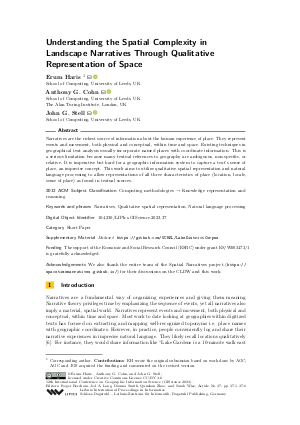LIPIcs.GIScience.2023.37.pdf
- Filesize: 0.77 MB
- 6 pages

 Creative Commons Attribution 4.0 International license
Creative Commons Attribution 4.0 International license

Narratives are the richest source of information about the human experience of place. They represent events and movement, both physical and conceptual, within time and space. Existing techniques in geographical text analysis usually incorporate named places with coordinate information. This is a serious limitation because many textual references to geography are ambiguous, non-specific, or relative. It is imperative but hard for a geographic information system to capture a text’s sense of place, an imprecise concept. This work aims to utilize qualitative spatial representation and natural language processing to allow representations of all three characteristics of place (location, locale, sense of place) as found in textual sources.
Feedback for Dagstuhl Publishing